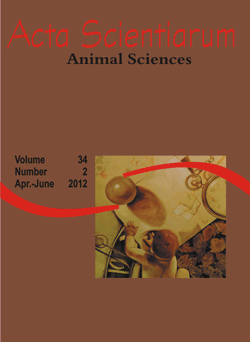<b>Effects of different sampling intervals on apparent protein and energy digestibility of common feed ingredients by juvenile oscar fish (<i>Astronotus ocellatus</i>)</b> - doi: 10.4025/actascianimsci.v34i2.10541
Abstract
This study evaluated the apparent protein and energy digestibility of common feed ingredients (soybean meal, fish meal, wheat meal and corn) by juvenile oscars using two different sampling intervals (30 min. and 12h). The 160 juvenile oscar fish tested (22.37 ± 3.06 g BW) were divided into four cylindrical plastic net cages, each one placed in a 1000 L feeding tank. The experiment was completely randomized in a 2 x 4 factorial design (2 feces collection intervals and 4 feed ingredients) with four replications. The statistical tests did not detect an interaction effect of sampling interval and type of ingredient on digestibility coefficients. Sampling interval did not affect protein and energy digestibility. The physical characteristics of juvenile oscar feces likely make them less susceptible to nutrient loss by leaching and can therefore be collected at longer intervals. Protein digestibility of the different ingredients was similar, showing that apparent digestibility of both animal and plant ingredients by juvenile oscars was efficient. Energy digestibility coefficients of fish meal and soybean meal were higher than those of wheat meal and corn. Carbohydrate-rich ingredients (wheat meal and corn) had the worst energy digestibility coefficients and are therefore not used efficiently by juvenile oscars.
Downloads
DECLARATION OF ORIGINALITY AND COPYRIGHTS
- I Declare that current article is original and has not been submitted for publication, in part or in whole, to any other national or international journal.
The copyrights belong exclusively to the authors. Published content is licensed under Creative Commons Attribution 4.0 (CC BY 4.0) guidelines, which allows sharing (copy and distribution of the material in any medium or format) and adaptation (remix, transform, and build upon the material) for any purpose, even commercially, under the terms of attribution.
Read this link for further information on how to use CC BY 4.0 properly.








































